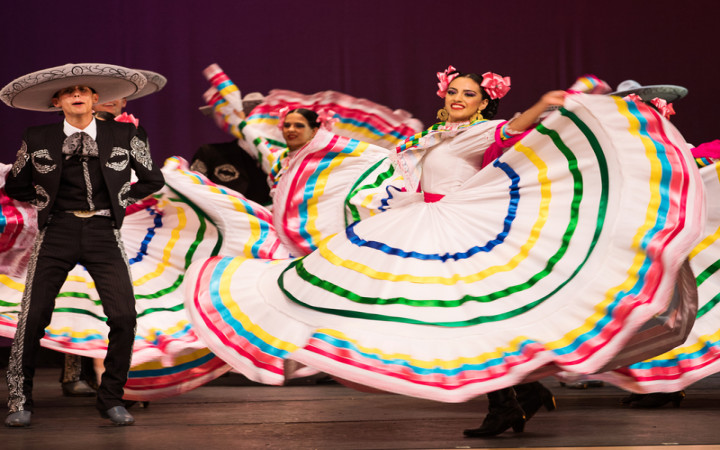Today’s Wonder of the Day was inspired by Maya. Maya Wonders, “What is folklorico?” Thanks for WONDERing with us, Maya!
You and your family or friends may have been to festivals with different cultures represented. Delicious food from other countries. Beautiful crafts made by people from all over the world. What about music and dance? Have you seen samba dancers? Or heard a catchy zydeco beat?
Maybe dancers tapping their feet have entranced you. Men waving handkerchiefs. Women rhythmically swirling and swishing their skirts at their sides. There are lots of brightly colored costumes. Sometimes the dancers sing and yell out. What is this fantastic performance? It’s folklórico, of course!
Folklórico is the Spanish-language word for folkloric. Folklórico is a type of dance, music, and costume which highlights several Mexican cultures. Some believe Spanish conquerors brought dance when they invaded Mexico. However, the indigenous peoples of Mexico already had dance and music traditions.
During Mexico’s colonial period (1525-1810), native dances changed. You could see the influence of immigrant cultures like Spain, Germany, and others.
Several Mexican states have their own special folklórico. How do people tell them apart? Individual states present their own costumes, music, and dance steps. Dances show something meaningful to each area. They tell stories about an animal, an event, or folklore.
The most well-known folklórico around the world is the jarabe tapatío. Known in English as the hat dance, it is the Jalisco state’s folklórico. The Mexican government adopted the jarabe tapatío as the national dance. Beginning in the 1920s, children learned the dance in the country’s schools.
Dancer and choreographer Amalia Hernández founded Ballet Folklórico de México in 1952. Hernández combined traditional dances with more modern movement. Along with updating the dance style, she created a full production. Her troupe of dancers won acclaim from Mexican leaders. They were invited to perform regularly. They also traveled the world. Ballet Folklórico de México is still performing and very popular today.
The most important part of any folklórico is the footwork. The dance sets the beat of the music. When there is singing, the dance very softly accompanies. Dancers wear shoes with nails on the toes and heels. Learning steps involves using the four parts of the foot. The toe, heel, ball, and sole work together and alone.
The design and color of a costume show its home region. Props used in dances are also important. Men may wear certain hats and masks or carry machetes. Women may wear veils and rebozos, or shawls. The way a dancer wears a costume can say something about the performer. The placement of a headdress can indicate whether a woman is married. The pocket into which a man tucks his kerchief is similar.
Dancers and educators agree that it is critical for folklórico to continue. It teaches about Mexico. The dance and music celebrate its people, culture, and history. Folklórico teachers and groups around the world continue teaching the traditions.
Do you have any music or dance traditions in your family? If not, what type might you start? It doesn’t have to be anything fancy—just something that shows off who you and your family are!
Standards: C3.D2.Geo.4, C3.D2.Geo.5, C3.D2.Geo.6, CCRA.R.1, CCRA.R.2, CCRA.R.5, CCRA.R.9, CCRA.R.10, CCRA.L.3, CCRA.L.4, CCRA.L.5, CCRA.L.6, CCRA.SL.1, CCRA.SL.3, CCRA.SL.4, CCRA.SL.5, CCRA.W.6, CCRA.W.8




